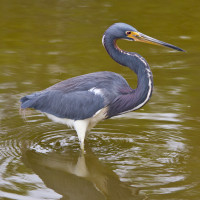Descrição
Jamaica Bay National Wildlife Refuge covers 12,600 acres of open bay, saltmarsh, mudflats, islands, upland field and woods and two man-made brackish ponds. It is one of the largest bird habitats in the northeastern United States and is a great place to observe the seasonal bird migration as well as resident species. 332 bird species have been sighted at the refuge over the last 25 years. Flat terrain, variety of habitat, seasonal influxes of birds. East pond access can be wet. Views of the Manhattan skyline.
Birding is excellent year round. In spring Jamaica Bay is visited by numerous shorebirds. You can also spot flycatchers, cuckoos, warblers, and tanagers. From mid-March through May courting American Woodcock can be seen. In summer many wading birds and terns can still be observed. Among the birds that nest in the area are Willet, Clapper Rail, Osprey, Yellow-crowned Night Heron, Tricolored Heron, Glossy Ibis, Forster's Tern, Ruby-throated Hummingbird, Willow Flycatcher, Boat-tailed Grackle, Saltmarsh Sparrow and Brown Thrasher. Shorebird migration starting in July.
Fall migration is also good with sometimes flocks of Cedar Waxwing, and many shorebirds, wading birds, raptors, flycatchers, sparrows and other songbirds. In winter you can find wintering waterfowl including Snow Goose and many dabbling and diving waterfowl species. But also birds of prey such as Northern Harrier.
Detalhes
Acesso
Jamaica Bay National Wildlife Refuge lies entirely within the boundaries of New York City and is located immediately west of John F. Kennedy International Airport. Driving directions from North, East, and West: Belt Parkway to Exit 17 S, Cross Bay Boulevard. Proceed south on Cross Bay Boulevard across the Joseph Addabbo - North Channel Bridge. The Visitor's Center is approximately 1.5 miles past the bridge on the right. Turn right at traffic light for Visitor's Center parking. Click on the P in the map for directions.
The parking at the Visitor Center is open 7 days, 6am - 9pm. Parking in the Visitor Center lot is free. The Visitor Center is open Friday through Monday 10am to 4pm. Subway access: Take the Rockaway Bound A train to Broad Channel Station. Walk along Noel Road to Cross Bay Boulevard. Turn right and walk three quarters of a mile to the Refuge Visitor Center.
Terreno e Habitat
Terras húmidas , Mar , Pequeno lago , Lamaçais , Árvores e arbustos dispersosCondições
Plano , Pantanoso , Sem sombraCaminho circular
Simé útil um telescópio?
Pode ser útilBoa temporada de observação de aves
Durante todo o anoMelhor hora para visitar
Migração da primavera , Migração de outono , InvernoRota
Caminho largo , Caminho estreitoCaminho dificil
Caminhada médiaAcessível por
PéAbrigo/plataforma deobservação de aves
SimInformação extra
The refuge is best seen on foot. The main trail to the West Pond departs just from the back entrance to the Visitor Center. Take the gravel trail that encircles the West Pond, following it in a clockwise direction. The trail is about 1 ½ miles and takes about an hour and a half to complete. Allow 4-6 hours to see the whole area. If you plan to go to the East Pond please have footwear that can get muddy, because the East Pond access can require shallow wading. Insect repellant is a good idea in summer.

